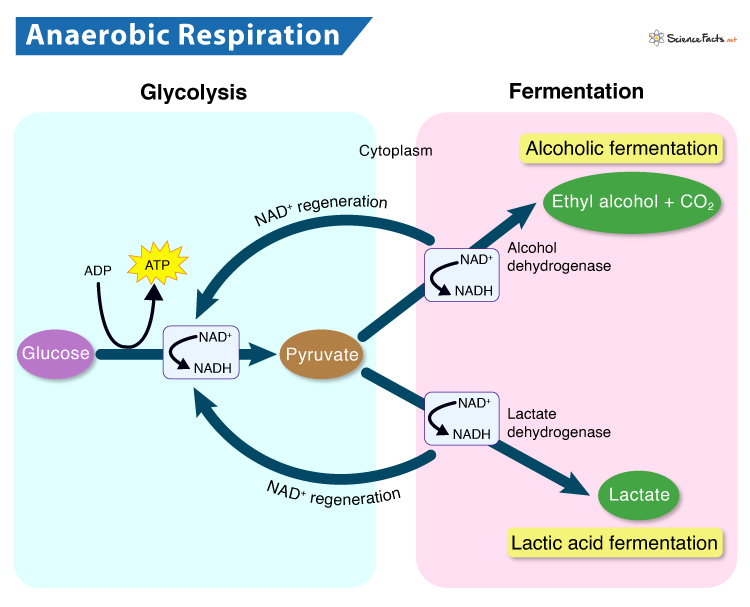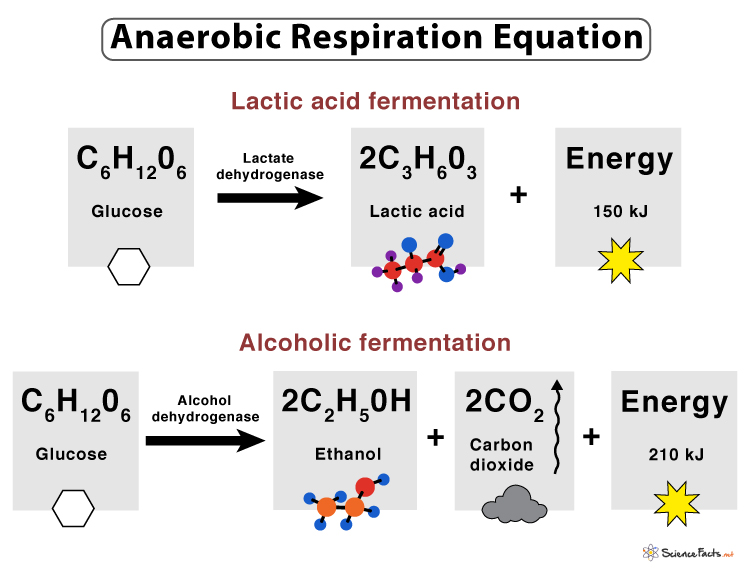Anaerobic Respiration
What is Anaerobic Respiration and Where Does it Occur
The term ‘anaerobic’ stands for ‘absence of air or free oxygen.’ Accordingly, anaerobic respiration is a type of cellular respiration, in which stored energy of glucose gets converted into biochemical energy coins, ATP without free oxygen. Many microorganisms rely on this process to produce energy when there is a lack of oxygen. These include prokaryotes, like bacteria and Archaea, and eukaryotes, such as plants and animals.
Many microorganisms use nitrate (NO3–) and sulfate (SO42-) as electron acceptors, reduce it to nitrite (NO2–) and hydrogen sulfide (H2S) respectively.
Anaerobic respiration exclusively occurs in the cell cytoplasm.
What Happens During Anaerobic Cellular Respiration
Similar to aerobic respiration, anaerobic respiration also starts with glycolysis by converting glucose into pyruvate. However, the pyruvate does not further enter the mitochondria to complete aerobic respiration due to the absence of oxygen. Instead, it follows a different pathway altogether and gets converted into a different byproduct in the cytosol only.
Steps of the Pathway
Anaerobic respiration occurs through two steps: glycolysis and fermentation.
1) Glycolysis
Glycolysis is the first and common step of cellular respiration. A glucose molecule splits into two pyruvate molecules, releasing electrons in the process and generating ATP.
In this 10-step biochemical pathway, 4 ATP molecules are formed by substrate-level phosphorylation. Among them, two ATP molecules are used up during the initial steps. Hence, the net yield is 2 ATP per glucose molecule.
Additionally, four electrons are released during the formation of NADH, which can be used to produce ATP by aerobic respiration.
2) Fermentation
Next, due to the absence of oxygen, the electron transport chain (ETC) fails to function as O2 is not present as the final electron acceptor. So, the pyruvate produced in the previous step cannot enter the mitochondria for aerobic respiration. As a result, there are an excess of NADH and pyruvate in the cytosol.
As glycolysis is the only energy-yielding phase of anaerobic respiration, it needs to be repeated frequently to produce ATPs within a short period. Glycolysis runs ceaselessly if a continuous supply of NAD+ is available. To fulfill that demand, the NADH produced in the previous step donates its electrons to pyruvate and converts into NAD+, producing organic acid or alcohol as a byproduct. This phenomenon of producing acid or alcohol from pyruvate by the action of NADH is referred to as fermentation.
How Many ATPs are Produced in Anaerobic Respiration
In anaerobic respiration, 2 molecules of ATP are produced from 1 molecule of glucose.
Types of Anaerobic Respiration
Two types of anaerobic respiration are found in living organisms.
1) Lactic acid Fermentation
In this process, NADH transfers its electrons directly to pyruvate, generating lactate as a byproduct. Lactate is just the deprotonated form of lactic acid, which gives the process its name. The lactate thus produced is cycled out of the cell and transported in the blood. A part of it goes to the liver and converts back to glucose during the Cori cycle. Glucose is essential for the cells.
This type of fermentation is generally used in mammalian red blood cells and skeletal muscle with insufficient oxygen supply. Muscle cells use an enzyme called lactate dehydrogenase for this process.
Equation
2 CH3COCOOH + 4 NADH → 2 C3H6O3 + 4 NAD+
Reactants
- Pyruvate (CH3COCOOH)
- Nicotinamide adenine dinucleotide (NADH)
End Products
- Lactic Acid (C3H6O3)
- Nicotinamide adenine dinucleotide (NAD+)
2) Alcoholic Fermentation
In this process, NADH donates its electrons to a pyruvate derivative, producing ethanol in two steps. In the initial step, a carboxyl group is removed from pyruvate and released as carbon dioxide, producing a two-carbon molecule called acetaldehyde. In the second step, NADH passes its electrons to acetaldehyde, regenerating NAD+ and forming ethanol. This process is also called ethanol fermentation, as the final product of this reaction is ethanol.
This process is conducted by microscopic organisms such as bacteria and some fungi such as yeast.
Equation
Step 1:
CH3COCOOH → CH3CHO + CO2
Step 2:
CH3CHO + NADH + H+ → C2H5OH + NAD+
Reactants
- Pyruvate (CH3COCOOH)
- Nicotinamide adenine dinucleotide (NADH)
End Products
- Acetaldehyde (CH3CHO)
- Ethanol (C2H5OH)
- Nicotinamide adenine dinucleotide (NAD+)
- Carbon dioxide (CO2)
Advantages of Anaerobic Respiration
- It is a relatively rapid process, producing ATP very quickly. For instance, it allows muscles to get the energy they need for short bursts of intense activity.
- It allows organisms to live in places with little or no oxygen, such as deep water and the digestive tracts of animals like humans.
- It can act as a backup when cellular oxygen is depleted in multi-cellular organisms that require oxygen, such as human beings.
- It can assist aerobic respiration by metabolizing pyruvic acid, the end product of glycolysis, and in the process, regenerating enzymes necessary for glycolysis, facilitating further aerobic respiration.
FAQs
Ans. Yeast is most likely to use anaerobic respiration.
Ans. The rate of anaerobic respiration increases with increasing temperature.
Ans. The rate of anaerobic respiration increases with increasing temperature.
Ans. Yes, fermentation is anaerobic respiration.
Ans. The differences in anaerobic respiration between plants and animals are:
a. In plants, the end products are ethanol and CO2. In animals, the end product is lactic acid.
b. In plants, the accumulation of ethanol may kill the plant. In animals, the lactic acid cannot cause death but may lead to minor muscle cramps that can be cured with a hot water bath or a massage.
c. In plants, CO2 gets released, but in animals, no CO2 is released.
Ans. In humans, anaerobic respiration occurs primarily in muscle cells during high-intensity exercise when there is less oxygen supply.
Ans. Anaerobic respiration is less efficient than aerobic respiration because it produces significantly less energy (2 ATPs) than aerobic respiration (38 ATPs).
-
References
Article was last reviewed on Thursday, February 2, 2023





